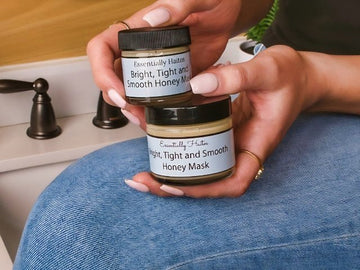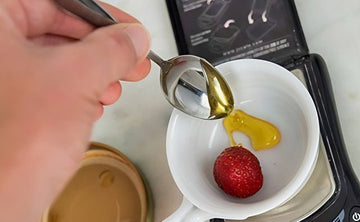What Exactly Is a Toner?
First things first, toners are a skincare product with a water-like consistency designed to help your skin in a few important ways. Ever since they became popular during the 90s, their purpose remains the same: remove dirt, prime skin for serums / moisturizers, and soothe.
Unfortunately, the original formulations contained quite a bit (a lot) of alcohol, which is why they’ve earned a bad rep for being harsh and drying. Thankfully, today’s formulations are much gentler, with different additives to tackle different skincare concerns. You can now find a toner for any skin type (more on that later).
So, What Do Toners Do?
Toners primarily remove excess dirt, oil, makeup, and other impurities that your cleanser leaves behind. That’s right—sometimes your cleanser doesn’t get it all!
Most importantly, the right toner also gives your skin a boost of active ingredients while prepping it for the next step in your routine.
Toners can be divided into three main categories: astringent toners, hydrating toners, and acid toners.
- The main ingredient in astringent toners is typically alcohol or other ingredients to cleanse and remove excess oil from the skin.
- Hydrating toners usually have a high water content to help improve and aid water retention plus ingredients to bind the water to your skin for longer-lasting results.
- Acid toners typically contain AHAs such as glycolic or lactic acid to act as a chemical exfoliant to help reduce the appearance of uneven skin tone.
What Are the Benefits of Using a Toner?
In general, it’s the removal of leftover impurities, but that’s not all there is to it!
Toners also help restore moisture and support your skin’s natural protective barrier by providing it with the hydration it needs to stay strong. Depending on what type of toner you choose and the active ingredients it contains, your toner can help you target specific skin concerns, such as oily or overly dry skin.
Toner Dos and Don’ts
You should apply your toner sometime between washing your face and applying your moisturizer.
Note: If you use serums in your routine, apply toner first – then serum(s) – then moisturizer. (If you apply toner after your serum, you’re essentially wiping off all the nutrients and active ingredients your serum provides.)
Applying toner is very simple, and you have a few options.
- You can put your toner in a spray bottle to spritz it on
- You can soak a cotton pad and wipe in an upward motion (this is a waste of toner in my opinion – too much is absorbed by the cotton)
- You can also use your hands (just make sure they’re clean) - pour a nickel-sized amount in the palm of your hand, and gently pat the toner onto your face and neck (my preferred method)
Once you’re done, let it dry before moving on to the next step of your routine.
Toner for Oily Skin
If you have oily skin, your overall goal is to remove that excess oil and replace it with balanced hydration. That means you’re looking for an astringent toner that typically contains AHAs such as glycolic, lactic, or citric acid. You can also use toners with ingredients such as witch hazel or BHAs like salicylic acid. These ingredients penetrate deep into your pores, right to your sebaceous glands, removing the excess oil, dead skin, and dirt.
Toner for Dry Skin
If you have dry skin, you should be on the lookout for ingredients that provide moisture and/or help water rise to the surface of your skin for hydration. In this case, your toner should have ingredients such as glycerin, vitamin E, hyaluronic acid, and aloe vera. These ingredients can provide your skin with the moisture and hydration it craves. However, try to avoid toners that contain higher levels of alcohol (i.e. one of the first ingredients on the list), as they can strip what little oil your skin has.
Toner for Sensitive Skin
Those with sensitive skin need a toner that removes impurities and provides all the benefits of a toner without harsh ingredients. Ingredients such as calendula, chamomile, aloe vera, and rose water are all very gentle on the skin. People with sensitive skin can use hyaluronic acid in their toner, but always patch test first.
While a toner may make your skin tingle, it should never sting, cause any pain, or make your skin feel tight. If you have sensitive skin, you should also avoid alcohol as an ingredient, and you should steer clear of fragrances, benzoyl peroxide, and retinol.
Do I Need a Toner in My Skincare Routine?
All skin types can benefit from using a toner; it’s just a matter of finding the right one.
Ultimately, what you need to know about facial toners—and the biggest lesson to take from this article—is that beauty products are not as mystifying as beauty gurus and skincare fanatics make them seem. Patch test and introduce one new product into your routine at a time (otherwise, you won’t know which product is making your skin better – or worse!).
If you’re interested in trying a facial toner, Essentially Haitos sells a standout toner, Clarifying Honey Toner, as part of its Clean B line. It's packed with standout herbal extracts that have clearing, brightening, and calming properties so that your skin is nourished, clear and ready for the next step in your routine.
Please let us know if you have any questions about skin care routines - or skin care in general. It's what we do and know - and we're always here to help. Reach out via DM @essentially_haitos (it's the fastest way to get or attention).







